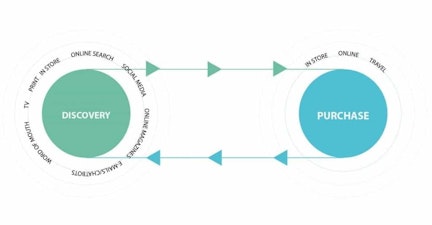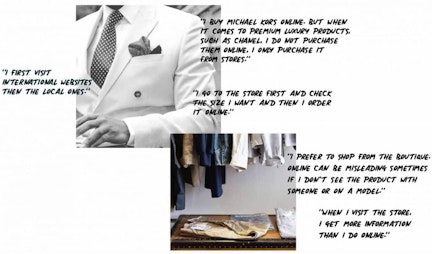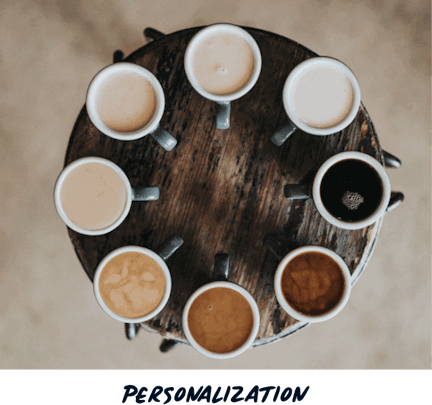
A world in a device

Mobile phones have changed the world we inhabit, becoming almost a natural extension of us. These inanimate devices have become ingrained in our everyday life, playing a fundamental role in how we interact daily. Smartphone ownership has become a necessity to function in modern society.
Based on our research, more than half of the women we interviewed from the UAE and Saudi Arabia claimed to own more than one smartphone. While more than half in both countries admit to being “addicted” to or “dependent” on their mobile phones. In fact, increasingly we’re seeing that users are attaching human emotions to their devices, as their connection and dependency heightens over time.
The relationship that these high-net-worth women in the UAE and Saudi Arabia have with their phones is indescribable. 90% of those surveyed in the UAE said that they could not spend more than 15 minutes without looking at their mobile phone. 83% of Saudi women confessed that their mobile phone makes them feel happy. This trend of attributing emotions to devices is fascinating, as we are in effect, witnessing people anthropomorphize their phones.
In the following spread, we delve deeper into what emotions our respondents associated with their mobile devices in more detail.

Mobile is key to brand noticeability

With mobile being a fundamental part of consumers’ lives, what does this mean for brands?
We caught up with Ian Manning, Head of Agency Relationships at Facebook and Instagram MENA, to get his thoughts on how mobile has changed the game. Below are some key insights from the interview.
ON MOBILE BEING A KEY PART OF THE MARKETING MIX
What sets mobile apart from other media is simply the amount of time we spend on it. People are very attached to their mobile devices and are, in effect, running their lives with them. Most other channels are fleeting. Take primetime TV, for example, you go there to watch a key program. What sets mobile apart is that it allows you to lean forward into content (that you find interesting or might have saved) or to discover new content.
ON VIDEO AD FORMATS
It’s not about which formats work better, it’s about what your objectives are, and which formats will help you get your message across in the most interesting and engaging way. Having said that, we’ve found that video is something that consumers enjoy. They like the audio-visual nature of it and being able to see the storyline within the video. However, video doesn’t need to be a 90-second video ad or a 30-second video, it can be as short as 2-3 seconds. It’s about getting users engaged with the video and making them understand the storyline in the shortest amount of time possible.
ON USING MOBILE AT EVERY STAGE OF THE FUNNEL
As brands use mobile more, they’ve realized that it can be used at multiple stages of the funnel, not just for awareness. One of the great things about mobile is that you can drive your consumers through the purchase journey over a period of time. For example, mobile brings to the table sequential advertising (changing ads based on what stage of the journey your consumer is at), reach and targeting capabilities that we haven’t had in the past. All of this together provides brands with a much more nuanced way of communicating and engaging with their consumers.
The complex path to purchase

The consumer’s path to purchase has undergone a drastic change. Empowered consumers have multiple touchpoints in their product discovery stage and have access to additional purchase gateways. This has made the consumer journey even more intricate.
The consumer journey used to be simple, with the discovery stage limited to only a few key touchpoints. In the past, consumers may have found a product through a print or TV ad, or through a friend’s recommendation. They would then go into the store to buy the product, perhaps discovering a few new products along the way; simplicity was key.
Technology has changed all that. The internet and subsequent mobile internet gave consumers more control to search information at the touch of a button, whenever and wherever they liked. As such, the consumer journey has become extremely complex, as they now have access to more touchpoints in the discovery and purchase stages of the funnel. Despite the instant information gratification that technology now affords, word-of-mouth still plays a vital role in the consumers decision-making process and is arguably one of the most trusted forms of advertising in the region.
Our research found that word of mouth is one of the key influences in luxury purchase decisions.
For brands to tap into this lucrative channel, making a meaningful connection is essential. Building up an authentic narrative and cultivating a sense of community are two key components in driving consumer loyalty. In today’s social-driven world, the ‘hard sell’ message will only switch people off. Brands must put the experience first to encourage organic conversations to thrive.

THE ROLE OF INFLUENCERS IN THE DISCOVERY PHASE
With the internet and mobile, the number of information sources that consumers have access to has increased drastically. Digital media has made the discovery phase immensely complex. Social media, search and email marketing are incredibly important sources of information for luxury purchases. Our research found that a conscious search for luxury products almost always starts with social, either by looking at brand social pages directly or through influencers. The importance of influencers in these luxury purchase decisions cannot be overstated.
An influencer can be a number of things –a celebrity endorsing a product, a beauty blogger/vlogger, or in some cases, even the brand itself acts as an influencer. Luxury shoppers in the UAE and Saudi Arabia crave more content from all three, especially on social media.
Compared to a study we conducted in 2015, consumers now find ads less annoying and won’t block them as much, which is telling of the consumer mindset when it comes to searching for information.

Nearly 3 in 5 say that blogger / influencer endorsements influence their purchase of luxury products.

Nearly 3 in 5 also believe that bloggers / experts / celebrities make them want to go and buy the luxury brand they’ve endorsed.

4 in 5 women are open to seeing luxury ads online via a computer or a mobile phone.
HOW ARE LUXURY CONSUMERS INFLUENCED?


THE RISE OF E-COMMERCE
Despite the rise of e-commerce in this region, online shopping will likely never replace the in-store experience. Based on PwC Middle East’s 2017 Retail Survey, 93% of high networth individuals prefer in-store shopping. This is largely due to a general mistrust of online shopping, particularly in Saudi Arabia.
However, this perception is starting to change. More luxury shoppers in the UAE (57%) and in Saudi Arabia (67%) are becoming comfortable with the idea of shopping online. As online prices are more competitive, the acceptance of making these purchases online have increased. Coupled with the rise of fashion e-commerce players in the region, it’s understandable that consumers are now more open to shopping online. Some of the most popular shopping websites across both markets are Ounass and Namshi, while UAE locals also buy from Amazon and Souq, as well as other online branded stores. With the launch of noon last year in both the UAE and Saudi Arabia (which happened to be one of the top trending topics for the latter country in 2017), consumers are spoilt for choice.
However, luxury buyers still fear fake or poor quality products. Due to this, some consumers put a limit on the amount they spend on luxury products online as a precaution, whereas others tend to buy only affordable luxury brands online, and not invest in premium luxury.
HOW DO LUXURY CONSUMERS COMPARE THE ONLINE AND IN-STORE EXPERIENCE?

What the future holds
UAE and Saudi luxury consumers expect a lot to change in the future. Here, we consider the four key trends that they see reshaping the industry as we know it.

Consumers crave more tailored and personalized experiences, and the respondents in our study are no exception. With this in mind, brands must appreciate the importance of the customer experience. With the amount of customer data that brands have access to, it is extremely important for them to unlock its full potential or risk getting left behind.

Reliance on chat doesn’t seem to be slowing down, with luxury consumers indicating a preference for more personalized communications on these platforms. Whether it’s through WhatsApp or custom built chatbots, the opportunity to enhance a brand’s social media/web experience should only be a click away. Consumers want things that are easy and chatbots, a valuable implement in the marketer’s toolbox, will augment the overall brand experience.

Virtual and augmented reality have been the much hyped technologies of recent years, yet few brands have taken advantage of them effectively. Interestingly, women imagine VR or AR to be used more in product launches, highlighting the story of the product from creation to sales. This indicates a desire for consumers to be more involved with the brand, through an immersive and emotionally-charged experience. Ultimately, it’s up to brands to utilize this technology to find new, smart ways to engage with their audiences, like for instance, deploying AR/VR in an environment that is likely to stimulate an emotive reaction.

The online retail space in this region is growing rapidly and consumers already have the perception that this will free up retail space. How should luxury brands approach e-commerce then? Luxury consumers still value being able to physically hold or try the products they want to buy. Brands must therefore consider online shopping touchpoints in their overall customer experience strategy and use it to their advantage. To survive, brands must leverage online platforms to encourage purchases in-store. Only then will they truly be able to build an omnichannel experience.
DETAILS OF THE STUDY
On behalf of OMD UAE, Hall & Partners MENA conducted interviews with industry experts, high-net-worth individuals and high-net-worth female luxury buyers in the UAE and Saudi Arabia.
From the collated data, we have produced this study, titled ‘The Future of Luxury in the Age of Mobile 2017’.
Other sources used: EMIR, Knight Frank Wealth Report, PwC Middle East’s 2017 Retail Survey, Bain & Company Luxury Study.
DOWNLOAD THE REPORT








